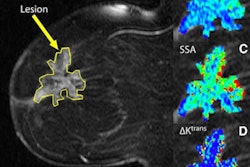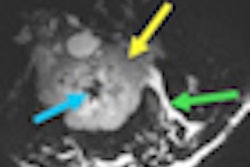Full-field digital mammography (FFDM) has higher sensitivity than analog technology when used for screening certain women, such as those with extremely dense breast tissue. Such women may want to ask for screening with FFDM systems, according to an article published online October 17 in the Annals of Internal Medicine.
Breast imaging facilities have been adopting FFDM technology with increasing frequency in recent years, but there hasn't been much data on whether the systems are more effective than traditional analog units -- in spite of their much higher price tags. A report issued in January 2011 by the Center for Public Integrity claimed that FFDM units have been adopted without evidence that they're effective in older women, and as a result, they are costing the Medicare system millions in extra costs due to the higher reimbursement rates for digital exams.
Clinical studies have produced conflicting findings, with some studies finding a benefit for certain types of women such as those with dense breast tissue, while others indicate that FFDM can lead to higher recall rates, according to Dr. Karla Kerlikowske and colleagues from the University of California, San Francisco (UCSF), who authored this month's article (Ann Intern Med, October 17, 2011).
A shortcoming of previous studies is that they used a small number of digital examinations, which produced few cases of breast cancer detection, the researchers noted. Also, older research suffered from variations in study design; to overcome these limitations, Kerlikowske's group used data from a single large-scale study, the Breast Cancer Surveillance Consortium (BCSC).
The BCSC data included 329,261 women ages 40 to 79 years who underwent 869,286 mammograms (231,034 were digital and 638,252 were film-screen) between January 2000 and December 2006. Breast cancer was diagnosed in 4,046 women (1,054 digital and 2,992 film-screen), primarily at nonacademic facilities (83%).
The researchers found the biggest advantage for FFDM in women with very dense breasts, with readers using FFDM recording a sensitivity of 83.6% versus 68.1% for those reading off analog breast exams. FFDM also recorded a major advantage in women with estrogen receptor-negative cancer (78.5% versus 65.8%).
Digital technology had less of an edge in women ages 60 to 69 years (89.9% for FFDM versus 83% for analog), whereas for women ages 40 to 49, readers using FFDM recorded sensitivity of 82.4% versus 75.6% for analog. The technology's sensitivity was borderline significantly lower than analog for women ages 50 to 59 years (80.5% versus 85.1%).
Based on the study's results, some women may want to opt for digital technology during breast screening, the authors concluded.
"Women aged 40 to 49 years who are being offered screening mammography may choose to undergo digital mammography to optimize cancer detection, because digital mammography is better at detecting tumors in extremely dense breasts and estrogen receptor-negative tumors, both of which are more likely in this age group," they wrote.
As for specificity between the two modalities, Kerlikowske's team found that it was similar by decade of age, except for women between the ages of 40 and 49, for whom FFDM was slightly less specific than film-screen mammography (88% versus 89.7%, respectively).
Finally, the team found that recall rates between FFDM and analog were comparable -- at 10% and 9.3%, respectively -- and cancer yield per biopsy was 25.3 for FFDM and 24.7 for film-screen mammography.




















